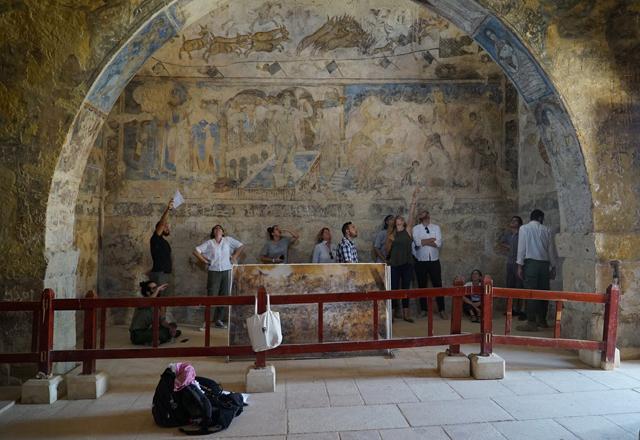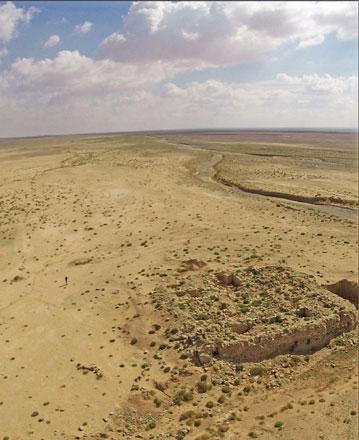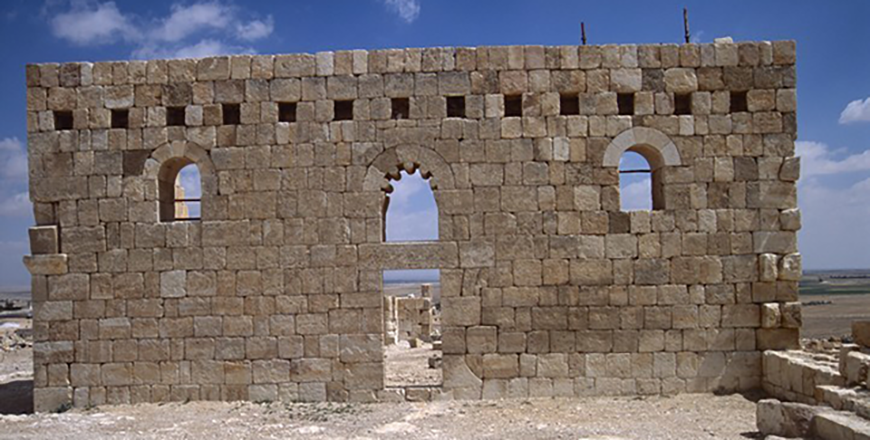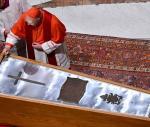You are here
Qusayr Amra a lens onto production of early Islamic art, architecture — scholar
By Saeb Rawashdeh - Sep 04,2017 - Last updated at Sep 05,2017

Participants of the Second Janet Abu Lughod Seminar visit Qusayr Amra site, 85km northeast of Amman, recently (Photo courtesy of Studio-X Amman)
AMMAN — The Second Janet Abu Lughod seminar, organised by Studio-X Amman and Sijal Institute for Arabic Language and Culture was a “wonderful opportunity to engage deeply with a diverse and bright group of participants in Amman on the singular topic of Qusayr Amra”, said Khaled Malas, a PhD candidate at the Institute of Fine Arts, New York University.
The late Janet Abu Lughod, after whom the seminar was named, was an urban sociologist whose major academic contribution was the development of world systems theory — a multidisciplinary, macro-scale approach to world history and social change.
Born in Damascus, Malas is a member of different artistic associations including the Arab Image Foundation, the Historians of Islamic Art Association and the London Institute of “Pataphysics”.
“When I was first approached to lead this seminar by the directors of Studio-X Amman, I perceived Qusayr Amra [85km northeast of Amman] as a lens onto the production of early Islamic art and architecture, and I hoped that a close examination of the building and its decoration would provide us all with a deeper understanding of space making and its relation to patronage, production and sovereignty, both in the past and today,” he said a recent e-mail interview.
Malas led a recent seminar on Umayyad palaces which explored the various manners in which the Qusayr Amra site may inform scholarly understandings of Umayyad architecture, courtly tastes, territorialisation practices and image-making technologies, organisers said on their web presentation, adding that “through mediaeval primary sources, 20th and 21st century academic writing [including texts present in the Abu Lughod Library], and artistic and architectural comparanda, we will place Qusayr Amra within an archipelago of associable Umayyad objects and monuments, both urban and sub-urban.”
The seminar took four weeks of intensive work between July and August, during which participants engaged in debates about Umayyad buildings in parts of northern Jordan, the scholar, who is interested in the early Islamic architecture, continued.
Seminar participants also visited the “desert palaces” of Qasr Al Kharanah, Qasr Al Mshatta and Qusay Amra to analyse early Islamic architecture.
“As a class, we are very wary of terming these early Umayyad buildings as ‘desert palaces’, since many of these sites were not located in the desolate landscape they are often imagined,” Malas explained.
“Furthermore, I believe that, based upon the readings conducted for the class and the discussions amongst each other regarding this scholarship, it would be fair to say that the participants and I conceive the archipelago of the Umayyad palaces as a strategy of territorialisation,” he said, adding that by territorialisation “we mean that they simultaneously produce territory at a variety of scales and procedures including the agricultural, the political, and the economic, in addition to securing resources such as water and tribal loyalty”.
“Finally, we were all quite fascinated by the diminishment of the palaces’ role in the early Abbasid period, which suggests the termination of whatever territorialisation role they may have initially performed by the end of the Umayyad period,” Malas highlighted.
Related Articles
AMMAN — Qusayr Amra, located approximately 80 kilometres east of Amman, is one of the desert castles typical for the early Islamic per
AMMAN — Qasr Mushash, located 40 kilometres east of Amman, was probably used for postal services during the Umayyad period, according to a G
AMMAN — The Umayyad period represents a very dynamic phase in the history of the Levant in terms of the political transition, architecture a



















